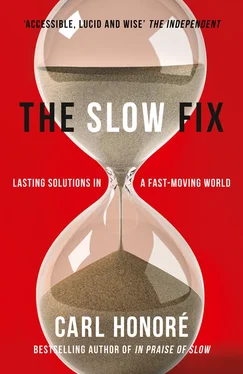‘Did the uber-nerds make any inroads?’ I ask.
‘No, nothing at all,’ says Boucher. ‘Eventually they left and we never heard from them again.’
Bill Gates, the high priest of high-speed problem-solving, has learned the same lesson. In 2005 he challenged the world’s scientists to come up with solutions to the biggest problems in global health in double-quick time. The Bill and Melinda Gates Foundation awarded $458 million in grants to 45 of the more than 1,500 proposals that flooded in. There was giddy talk of creating, for instance, vaccines that needed no refrigeration within five years. But five years later the mood was sober. Even the most promising projects were still a long way from delivering real solutions. ‘We were naïve when we began,’ Gates conceded.
The bottom line here is clear: the quick fix is the wrong horse to back. On its own , no algorithm has ever solved a global health problem. No impulse buy has ever turned around a life. No drug has ever cured a chronic illness. No box of chocolates has ever mended a broken relationship. No educational DVD has ever transformed a child into a baby Einstein. No TED Talk has ever changed the world. No drone strike has ever killed off a terrorist group. It’s always more complicated than that.
Everywhere you look – health, politics, education, relationships, business, diplomacy, finance, the environment – the problems we face are more complex and more pressing than ever before. Piss-poor performance is no longer an option. The time has come to resist the siren call of half-baked solutions and short-term palliatives and start fixing things properly. We need to find a new and better way to tackle every kind of problem. We need to learn the art of the Slow Fix. Now is the moment to define our terms. Not all problems are created equal. Some can be fixed with a quick and simple solution. Inserting a single line of code can stop a misfiring webpage from inflicting mayhem on a company. When someone is choking on a morsel of food, the Heimlich manoeuvre can dislodge the offending object from the windpipe and save the victim’s life. My focus in this book is on a very different kind of problem, where the parameters are unclear and shifting, where human behaviour comes into play, where there may not even be a right answer. Think climate change, the obesity epidemic, or a company grown too big for its own good.
When dealing with such problems, the quick fix addresses the symptoms rather than the root cause. It puts short-term relief before long-term cure. It makes no provision for unwelcome side effects. Every culture has a tradition of skin-deep fixes. The French call it a ‘solution de fortune’. The Argentines ‘tie it all up with wire’. In English we talk of ‘band-aid cures’ and ‘duct-tape solutions’. The Finns joke about mending a puncture with chewing-gum. The Hindi word ‘jugaad’ means solving problems – from building cars to repairing water pumps – by throwing together whatever scraps are to hand. My favourite metaphor for the folly of the quick fix is the Korean expression ‘peeing on a frozen leg’: warm urine delivers instant relief, followed by worse misery as the liquid freezes solid on the skin.
So what is the Slow Fix? That is the question we will answer in the coming pages. But already it seems clear that it rests on a virtue that is in short supply nowadays: patience.
Sam Micklus knows that better than most. He is the founder of Odyssey of the Mind, the closest thing we have to an Olympics of problem-solving. Every year, pupils in 5,000 schools around the world set out to tackle one of six problems set by Micklus himself. They might have to build a weight-bearing structure from balsa wood, stage a play where a food defends itself in a mock court from charges of being unhealthy, or depict the discovery of archaeological treasures from the past and the future. Teams square off in regional and then national competitions to win a place at the annual World Finals. NASA is the chief sponsor of Odyssey of the Mind, and sends staff along to scout for talent.
I catch up with Micklus at the 2010 World Finals in East Lansing, Michigan. A retired professor of industrial design from New Jersey, he now lives in Florida, and looks every inch the American pensioner, with his comfortable shoes, silver hair and light tan. At the World Finals, however, surrounded by the hubbub of children pulling on costumes and fine-tuning their presentations for the judges, he is buzzing like a kid on Christmas morning. Everyone refers to him fondly as Dr Sam.
During 30 years at the helm of Odyssey of the Mind, Micklus has watched the cult of the quick fix tighten its grip on popular culture. ‘The real trouble nowadays is that no one wants to wait for anything any more,’ he says. ‘When I ask people to think about a problem even for just a minute or two, they are already looking at their watches after ten seconds.’
He takes a sip of water from a plastic bottle and looks around the enormous gymnasium where we are chatting. It feels like backstage at a West End musical, with children scurrying to and fro, bellowing instructions, assembling stage props and testing surprisingly elaborate floats. Micklus’s eyes come to rest on a clutch of 11-year-old girls struggling to fix a faulty chain on their homemade camper van.
‘Even here at the World Finals, where you’re talking about the best problem-solvers of the future, a lot of the kids still want to pounce on the first idea that comes along and make it work immediately,’ he says. ‘But your first idea is usually not your best, and it may take weeks or even longer to find the right solution to a problem and then make it come to fruition.’
No one, not even Micklus, believes we have to solve every problem slowly. There are times – patching up a soldier on the battlefield, for instance, or cooling a damaged nuclear reactor in Japan – when sitting back to stroke your chin and ponder the big picture and the long term is not an option. You have to channel MacGyver, reach for the duct tape and cobble together a solution that works right now. When the astronauts on the Apollo 13 radioed Houston about their ‘problem’ back in 1970, the boffins at NASA mission control did not launch a full inquiry into what caused the space craft’s oxygen tanks to explode. Instead, they rolled up their sleeves and toiled round the clock to devise a quick-and-dirty workaround that would modify the carbon dioxide filters so the astronauts could use the lunar module as a lifeboat. Inside 40 hours the crack problem-solvers in Houston came up with an ingenious solution using materials on board the ship: cardboard, suit hoses, plastic stowage bags, even duct tape. It was not a permanent fix, but it brought the Apollo 13 crew home safely. Afterwards NASA pulled the Andon rope, spending thousands of hours working out exactly what went wrong with those oxygen tanks and devising a Slow Fix to make sure they never exploded again.
Yet how many of us follow NASA’s lead? When a quick fix eases the symptoms of a problem, as that acupuncture session did for my back, our appetite for pulling the Andon rope tends to fade. After a tidal wave of bad debt threatened to torpedo the world economy in 2008, governments around the world swiftly put together bail-outs totalling over $5 trillion dollars. That was the necessary quick fix. Once the threat of global meltdown receded, however, so too did the will to follow up with a deeper fix. Everywhere, politicians failed to push through the sort of root and branch reform that would guard against Financial Armageddon 2: The Sequel .
Too often, when a quick fix goes wrong, we wring our hands, promise to turn over a new leaf and then go back to making the same mistakes all over again. ‘Even when a more fundamental change is required, people still go into quick-fix mode,’ says Ranjay Gulati, a professor of business administration at Harvard Business School. ‘They appear to make the right noises and take the right steps, but ultimately they fail to follow through, so that what starts out as a slow fix ends up being just another quick fix. This is a common problem.’
Читать дальше












